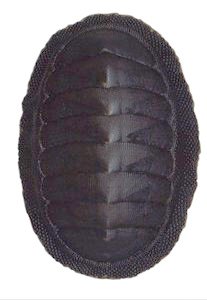|
TRANSLATIONS
We will now move on to mama:
|
A few preliminary
remarks and imaginations:
1.
The word mama implies an 'open
mouth', it seems. A limpet has only one shell and its
other side is pressed firmly against the rock, like a mouth.
The following is the beginning of the Poem of the
Elders (ref. Sharp as a Knife), and in the beginning, it says,
the newborn gods were sleeping together in disorderly fashion on a
rock awash in the saltwater, 'like sea-cucumbers' with 'their mouths
against it':
|
Aanishaw tangagyanggang, wansuuga. |
Hereabouts
was all saltwater, they say. |
|
Li xitgwaangas, Xhuuya aa. |
He was
flying all around, the Raven was, |
|
Tigu
qqawgashlingaay gi lla quaangas. |
looking for
land that he could stand on. |
|
Qawdihaw
gwaay ghutgwa nang qaadla qqaayghudyas, |
After a
time, at the toe of the Islands, there was one rock
awash. |
|
llagu
qqawghaayghan llagha lla xiidas. |
He flew
there to sit. |
|
Aa ttl
sghaana quiidas yasgagas ghiinuusis gangaang |
Like
sea-cucumbers, gods lay across it, |
|
llagu gutgwii xhihldagahldiyaagas. |
putting
their mouths against it side by side. |
|
Ga
sghaanagwaay ghaaxas lla ttista qqaa sqqagilaangas, |
The newborn
gods were sleeping, out along the reef, |
|
ttl
gwiixhang xhahlgwii at wagwii aa. |
heads and
tails in all directions. |
|
Ghaadagas
gyaanhaw ising ghaalgagang, wansuuga ... |
It was
light then, and it turned to night, they say ... |
The mouth signifies the end and once again
we find how the end merges with a new beginning.
Henua ora is
the picture of an upside down vulva and at the western horizon there
is a 'mouth' which 'swallows' (cfr How Maui gave mortality to Man)
all who earlier have been 'born' at the horizon in the east. In Mayan thought
it was illustrated as a grasping hand (manik):
|
|
"... the modern Homo
occidentalis is bound to shrink back from the mere idea that the
Nile represented a circle, where 'source' and 'mouth' meet, so that
there is nothing preposterous in the notion that a Canopic mouth can
be found in the geographical North ..." (Hamlet's Mill)
Water runs downhill, from its source high up and down to the sea,
where the 'mouth' of the river connects to the sea. Therefore the
Egyptian Nile points to the geographical North as the end station
(as if it was located at the horizon in the west). It is a more or
less straight path, not a circle.
In the cosmos of life curved paths do not describe circles,
they describe oscillations, i.e. waves with ups and downs. One wave
is more or less the same as the next. Therefore the end of one wave
merges with the beginning of next. It is like the pattern of ebb and
flood:

From this it is clear that vaha mea glyphs
have not been chosen to illustrate beginning simply by cause of the
colour red (mea) in the gills of fishes. A beginning can be
located where it is dark without any sign of light, and still
vaha mea glyphs can be used, for instance as in Gb7-25:
|
|
2.
The picture below shows a lined chiton (Tonicella
lineata) with its head at left and tail end
at right (source: Wikipedia):
This eyecatching animal invites
us to count.
8 plates it has and 6 of them carry
triangular marks.
Its bright yellow spots
are arranged with one spot at the head end and
with 7
more on each side, altogether 15 yellow
'sunspots'.
When Metoro said mama it was
presumably because he identifed the chevron
pattern in the mama glyph type with
the
pattern of plates on a chiton.
|
|
3.
The limpet which on Easter Island was named mama
is a black
one (Chiton magnificus):

Wikipedia gave me this picture, where the pattern of
plates on the shell is difficult to see. Eyes are not much help when
trying to perceive in the dark. But so much is certain that
the pattern is of the same general type as on the brightly coloured Tonicella
lineata on the previous page.
I believe the pattern of chevrons inside the ovals of the mama
glyphs are meant to indicate black or the lack of light.
Lines across henua glyphs in the calendars for
the week, e.g. in Tuesday, can presumably be understood as signs of
'nighttime' (because planets cannot be seen in the daytime):
|
Mars |
 |
 |
 |
|
Hb9-30 |
Hb9-31 |
Hb9-32 |
 |
 |
 |
|
Pb10-39 |
Pb10-40 |
Pb10-41 |
The 'strangling strings' in Aa1-11 probably
is another example of this type of 'night' sign:
|
|